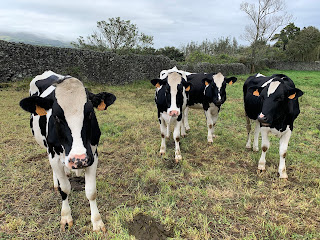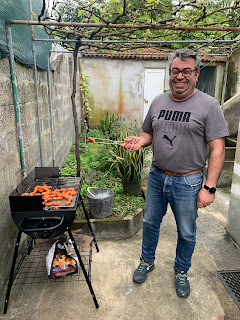The weather this morning is fucking atrocious. Last night it felt like the wind and rain was going to smash through our bedroom window. Now, as I sit typing on the laptop, the rain has turned to hail and is pelting the window and roof. No walk this morning and there’s been talk of heading to the shopping mall with Ana’s folks.After shivering through breakfast we pack John and Maria into the car and head to the Parque Atlantico mall. There, I set myself up with the laptop in the food court and have 90 minutes of joyous, solitary writing while the rest of them browse the retail delights. Normally I can’t pass within a hundred feet of mall food courts, but this one doesn’t have that sickening smell the ones back home do, which I’ve always suspected comes from Subway. The place fills in as noon approaches and soon it is packed. I notice that most people are eating the American fast food junk like KFC, Burger King, and McDonalds, all of which are here, instead of the more traditional Portuguese ones. God help their waistlines and arteries.
Ana learns from her mom that one of her Portuguese neighbours had given her twenty bucks and asked her to donate it to a church in downtown Ponta Delgada. Back when Maria and John lived here as teenagers, we are told, people went to this church with donations and gave them to these nuns who lived here, then in exchange they would get a small medallion. Maria tells us this story.
“And you think that fifty years later, it still works like that?” Ana asks.
“Oh, I don’t know,” Maria says. But she knows. Somehow.
Because the weather is still bad, but improving, we take on the donation mission and drive downtown and have a hell of a time finding parking near the huge downtown church, which is the one we assumed we were going to and nobody in the car said anything different. We finally snag a spot, then walk with John and Maria to the Igreja Matriz de São Sebastião, a magnificent architectural wonder right in the heart of the city.
“This isn’t the right church,” says John shaking his head.
“What? What do you mean?” asks Ana, confused. “This is the big church downtown.”
“Nope. Not this one. It’s a different one,” says John.
“Well why didn’t you say something before? How far is it?”
“Muito longe,” says Maria, pointing far off into the western horizon.
“Can we walk there?” I ask.
“Nahhhhhhh, nao e possivel,” says Maria, shaking her head and abandoning the plan.
“Well let’s try, we have nothing else to do,” says Ana.
We begin walking west along the beautiful walkways, intricately patterned with black and white cobblestone. It has stopped raining and is now just windy, but not awful. After walking two short blocks we see another church.
“There it is,” says John, pointing. “That one!”
Ana and I look at each other and shake our heads. I guess things always seemed a bit further when you were thirteen years old. We walk up to the front doors of the church. There are two young guys there holding out plastic cups, asking for money. They looked completely drugged out so we shuffle past them and go inside. There are a number of people there praying and John interrupts one of them in his booming deaf-man voice and asks where the donations are made nowadays. She points out where to go and we leave, hurrying past the street dudes again, avoiding eye contact. As we are walking up the street, John’s hat is flipped off from the wind and blown beneath a car. One of the druggies and I lock eyes, then look to the car. It’s a race. I race over to one side, he goes to the other, then we are both prone on our stomachs reaching beneath the car for the hat. I know if he gets it first we’ll have to pay him, and I’ll be in big trouble with Ana if I give money to a druggie. Just as he gets a finger on the brim, I hook the back of it and pull it towards me, success! This jolt of happiness is quickly replaced with a sense of dread, wondering what wrestling a mentally ill and drug addicted, poverty-stricken young man in front of the holiest church in the land will do to my karma count, but I’m thinking the donation to the nuns might even things out.
John and I catch up to the ladies at a side door to the church. They are standing in front of a weird wooden roller thing built into the stone church wall. Ana says, “Kris we can’t reach the rope – ring the bell.” I look to where she’s pointing and see a rope dangling from an ancient bell. I walk over, grab the rope and yank it, which produces a mighty ring. Nothing much happens, so I ring it again. Suddenly, the wooden dumbwaiter starts to move. I walk over to take a closer look and arrive just in time to see a twenty-dollar bill on a plate sliding across the concrete mantle and disappearing into the church wall. There is a pause. Then the wooden dumbwaiter rotates again, exposing another plate with a religious booklet, a wooden rosary, and a keychain. Maria pockets the goodies in safekeeping for her friend. Ana tosses a euro tenner on the plate and waits a moment, then the wooden thing spins again. Seconds later, a plate appears with just a rosary, and Ana snatches it up. Our karma count is reset.
Once again, we’re proven wrong by Maria, and fifty years later the only thing that’s changed with the donation system is you can no longer see the nuns. And the prizes seem a bit better. After a nice café lunch of cod and chips, the folks decide to take the bus back to Livramento, leaving Ana and I to browse around the city for a couple of hours. She browses some shops, we go for coffee and snacks, then I go on a wild and uncharacteristic shopping spree at the Peter’s Café Sport shop near the marina. I buy a sweatshirt, tshirt, hat, and coffee cup, all branded with the sperm whale logo. If you are a sailor you probably already know about Peter’s Café Sport, but if not, pop it into Google for an interesting read.

It's Friday night and of course there’s a party to go to. Tio Luis and his wife Genoveva are celebrating their grand-daughter Iris’s 18 birthday and we got a golden ticket. One thing about Azoreans – they are consistent. Whenever you visit an Azorean’s house, they will first take you straight back to their garden to show it off. That’s just what they do. It doesn’t matter if they have just a few tomato plants, or a grape vine canopy over their patio, or, in Tio Luis’s case, a sprawling garden with kale, rosemary, lemons, oranges, onions, carrots, coriander, tangerines, dill, grapes, plums, potatoes, parsley, yams, bananas, and three goddamn coffee trees from which they make their own coffee. The garden is always the first place you visit. After that you get to see their house, meet their wife, and sample two or three varieties of the home brew they have displayed proudly on the hutch.

The party is epic. Though the main floor of their house is fairly small, they still manage to seat thirty people at multiple tables. Ana and I ask to get reassigned from the table with her parents and Manuel (who we’ve been spending 24 hours per day with) to the so called “young table” with a bunch of cousins who are mostly either pushing fifty or already there, plus a few in their twenties. They are all a hell of a lot of fun. It is a long and leisurely dinner and I’m positioned by the fridge so every thirty seconds or so I do my bartender duty and retrieve beers or wine. It’s mostly a barrage of Portuguese but a few of the cousins do speak English, or at least some English, sometimes reluctantly, so communication is fun and an odd mix of both languages.
We leave sometime after midnight, but the fun continues, as the young kids have started up a big game of soccer in the backyard. It was a great party.












































